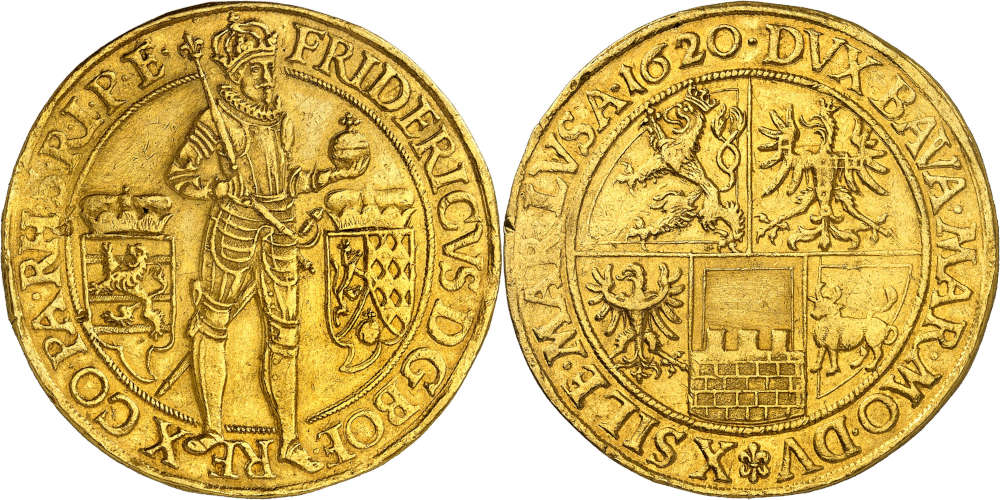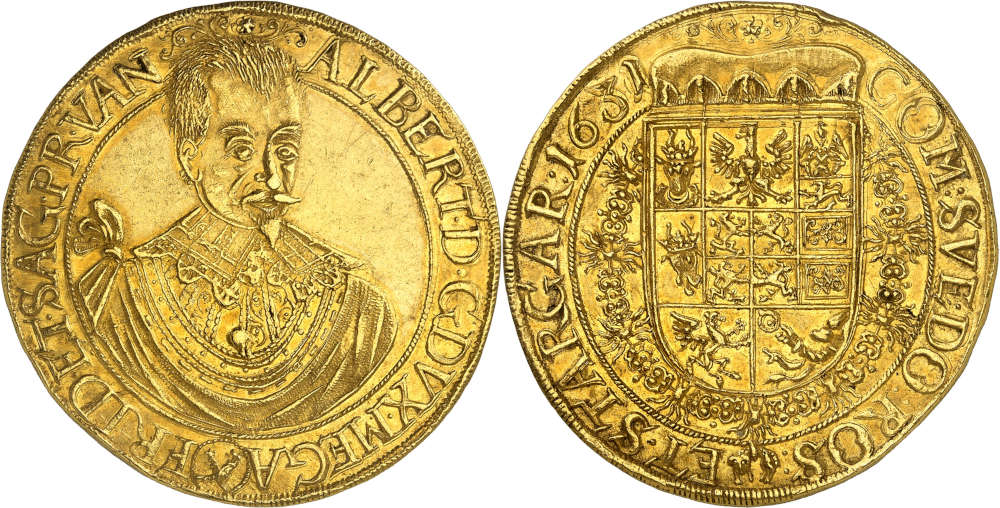Künker to Kick Off the Numismatic Year with a Bang
Künker
Auction 418
Coins
29 January 2025
D-Berlin
701 lots with a total estimate of 10 million euros: anyone who can do the math knows what that means. Künker presents its flagship sale, which – as always – will be held in the context of the World Money Fair. The highlights of several collections will be sold at this auction. Look forward to rarities from the time of the Thirty Years’ War and from the world of medals. The spectrum ranges from a portrait denarius of Charlemagne to gold multiples and gnadenpfennigs. No matter what you collect, the catalog is well worth a look – even if you cannot afford to purchase all these treasures. Of course, the estimates reflect the importance of these pieces and are therefore mostly in the four-figure range. Other estimates are in the three-, five-, and six-figure range.
But no matter your budget, if you love coins, you will surely be delighted to see such rare pieces in such perfect quality!
Minted History of the Thirty Years’ War and the Peace of Westphalia
The auction begins with the second part of the collection of a German manufacturer and history enthusiast comprising coins and medals from the time of the Thirty Years’ War. The first part of this collection was successfully auctioned by Künker on 23 September 2024 as part of auction 410. The 436 lots had an estimate of 4.25 million euros and sold for 7.5 million euros. This did not come as a surprise to connoisseurs: gold coins and multiple talers of perfect quality are currently fetching record prices. It would therefore not be surprising, if the top pieces of this collection, which will now be offered in the second part, generated considerably more than their estimate of 3.3 million euros.
Experts will appreciate the many rarities, the multiple talers and multiple ducats! Any writer tasked with selecting individual pieces to highlight in an auction preview will be spoilt for choice! But allow me to make things easier and let a few images speak for themselves.
A Unique Ensemble of Gnadenpfennigs
The term “gnadenpfennig” is used by numismatists to refer to a group of heavy gold coins with an elaborate contemporary mount, added to allow the owner to wear the specimen on a necklace or a headpiece. Such gnadenpfennigs were badges of honor given by princes to their most important officials and councilors. The possession of a gnadenpfennig of one or several rulers was a coveted symbol of status and privilege, especially for imperial knights. That is why people liked to wear them on portraits. In fact, very few of these precious objects have survived to this day. And that should come as no surprise. These coins were objects of daily use and therefore subject to wear and tear. In addition, they lost much of their prestige after the death of the prince depicted on them. It is therefore likely that many gnadenpfennigs were later melted down. Only a few of them still exist today. Künker is proud to be able to offer some of them in its Berlin Auction Sale. Here are a few selected examples.
Masterpieces of Medallic Art
Are you fascinated by medals? Then you should definitely take a close look at the Berlin Auction catalog, which features the finest and most beautiful medals created between the Renaissance and the 19th century. The medals are from several collections that complement each other. One of them belonged to the German manufacturer and history enthusiast who also created the collection of numismatic issues from the Thirty Years’ War.

No. 701: India. Silver cast medal n.d. (around 1890) commemorating the zoological garden of Alipore near Kolkata. Extremely rare. Extremely fine. Estimate: 10,000 euros.
In 1876, Edward VII, Prince of Wales, opened the Alipore Zoo, then the finest residential address in Kolkata. At the time, there was already a world-famous botanical garden in the neighborhood, built in the Western style. The zoo was to become famous for its breeding of white tigers, which began in the 19th century. The Aldabra giant tortoise, which was given to the zoo as a gift when it opened, was considered the world’s oldest animal in captivity when it died in 2006 at the age of 256.
World Rarities in Gold and Silver
No matter what field you are interested in, auction 418 features the very coin that could become a centerpiece of your collection. The offer ranges from Charlemagne to Elizabeth II of England. There are treasures from the German States, Europe, Asia and the United States of America, all of which have just two things in common: they are extremely rare and of above-average quality.
Russian Treasures
Collectors of Russian coins will find an interesting selection of extremely rare pieces. There are 64 lots to choose from, ranging from issues of Peter the Great to that of Tsar Nicholas II. Many of the pieces are of particular historical interest, for example a “Trubetskoy ruble”, created after the model of the 1825 Constantine ruble for the Russian consul in Marseille. Trubetskoy is said to have tried to sell these rubles as genuine Constantine rubles at the time. At least as exciting is a gold medal commemorating the landmark peace with Persia in 1828, which led to the establishment of an Armenian district under Russian rule. Thousands of Armenians from the Iranian and Ottoman Empires found a new home there.
Please not that, unlike previous years, the auction will not take place on the Thursday before the World Money Fair, but on the Wednesday, 29 January 2025!
To order a catalog contact Künker, Nobbenburger Straße 4a, 49076 Osnabrück; phone: +49 541 / 962020; fax: +49 541 / 9620222; or via e-mail.





































